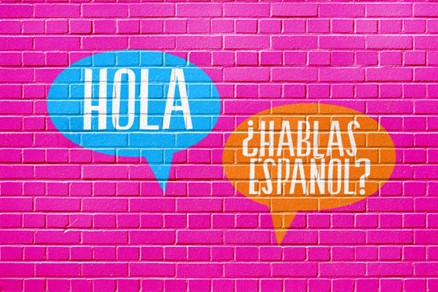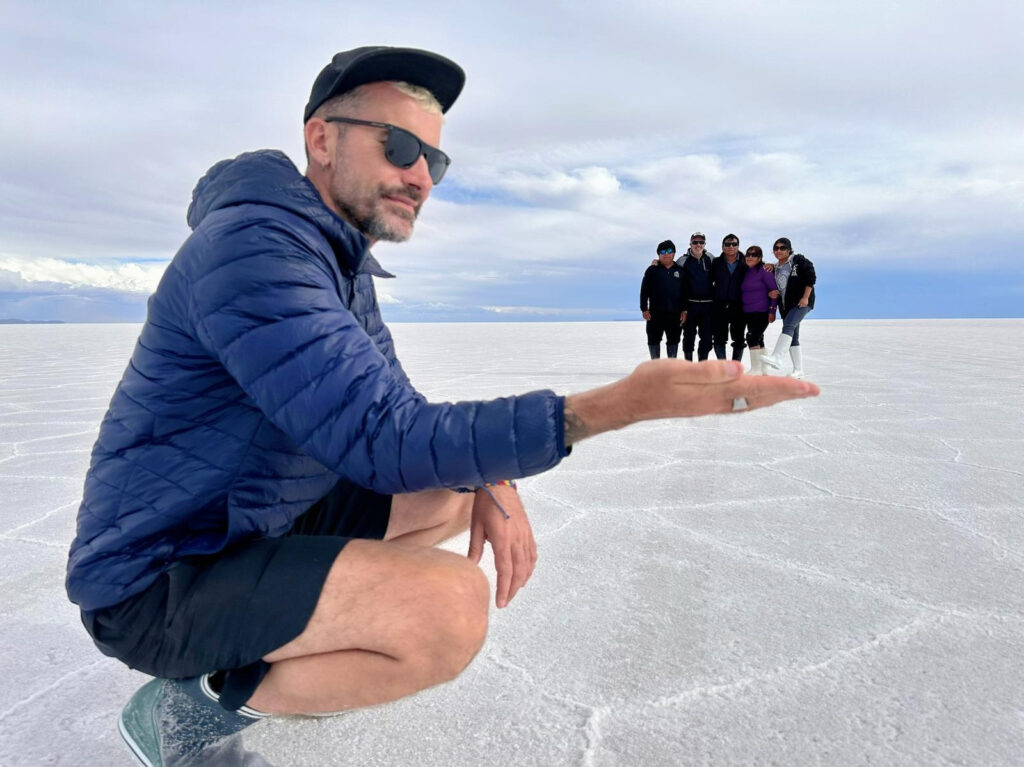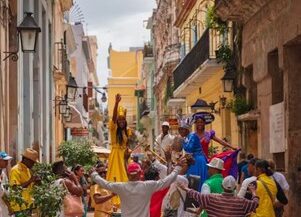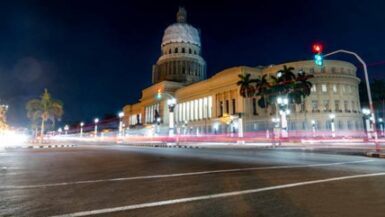

As I did travelled through South America and Central America , I learnt different languages in the recent years and of course all the Spanish varieties in that region with al those spanish-speaking countries. The slang terms and the rhythmic intonation can be different following the countries and of course the Cuban accent is very typical ( their is always regional differences ) . Get ready to learn some Cuban slang words !
The best way to learn is to make Cuban friends for English translations or find a Spanish teacher if you want to immerse yourself in this rich culture
The dominant languages are Spanish and English ( a lot of people speaks English in the tourist areas and tourist resorts ). Foreign languages like French are spoken too in Hotel .
Cuba is an amazing place with a vibrant diversity of the population, european influences and a rich history ! The perfect tourist destination

Enjoy the beautiful island of Cuba !
⚠️ Don’t forget our complete guides about Cuba
✅Cuba’s food and national dishes
☝🏻 And way more about the world
🔍 Just type the topic / country you choose in the search bar for all our articles

A Brief Historical Tour of the Diverse Languages Spoken in Cuba
Welcome to Cuba, a vibrant island nation where language, culture, and history all intertwine to make a unique fabric. In this inquiry, we will look at the numerous languages used in Cuba as well as briefly review its historical background to learn about the causes that have shaped the country’s linguistic makeup.

The Importance of Spanish
The Canary Islands, a group of Spanish islands off the coast of northwest Africa, had an important role in shaping Cuba’s linguistic identity. At the beginning of the 16th century, Spanish explorers such as Christopher Columbus started off on missions to the New World. Canary Islanders were among them, and they brought not only their hopes and dreams, but also their language, which contributed to the creation of Cuba’s linguistic mosaic.
By the 20th centuries, Spanish had established itself as Cuba’s official language. Spanish, which has its origins in the Iberian Peninsula and is affected by a diversity of civilizations in the Canary Islands, has evolved into a language that unites the Cuban people.
An Orchestra of Words in Spanish
Spanish is now officially designated as the national language of Cuba. It may be heard in the colonial architecture of Trinidad, dancing through the streets of Havana, and reverberating with the exuberant beats of Cuban music. Spanish is a living legacy to the island’s rich past, and it is spoken by nearly 11 million natives.
Shifting Winds in the 20th centuries
During the 20th centuries, Cuba’s socio-political environment saw significant changes. From the early years of American influence to the subsequent revolutionary fervor headed by Fidel Castro, these developments had a considerable impact on the languages used in the country.

United States
The United States had a tremendous political and economic influence on Cuba in the early 20th centuries, but it also left an enduring linguistic imprint. English, Uncle Sam’s language, was deeply embedded in Cuban society, leaving its imprint on urban areas, commercial transactions, and even popular culture.
When American enterprises controlled the majority of the Cuban economy, this linguistic interchange reached its peak. Cubans’ everyday speech was saturated with English words and phrases, resulting in a linguistic fusion that paralleled the two countries’ complicated dance.
Bringing Cultures Together
As Cuba came to terms with its revolutionary character in the late 20th centuries, the necessity to maintain and advance the island’s cultural tradition was emphasized. The vibrant mix of Spanish and bits and pieces of English from previous times evolved into a separate language that mirrored Cuba’s historical destiny.
On the streets of Havana, you may hear residents chatting in a rhythmic mix of Spanish and English, reflecting the syncopated beats of Afro-Cuban music. Cuba has proved its ability to adapt and reinvent the languages that have arrived on its shores as a result of this cultural confluence.

Adaptability and Resilience
Despite these impacts, Spanish remains the official language of Cuba. Because of the resilience of the linguistic roots planted by the first immigrants from the Canary Islands and the revolutionary spirit that acknowledged and loved Cuban nationality, Spanish has resisted the storm of outside influences.
Despite the fact that English has left its mark on the urban landscape and entered various elements of Cuban life, the heart and soul of Cuba continue to beat to the rhythm of Spanish. Spanish is a living testament to the island nation’s cultural resilience; it is spoken on the streets, in people’s homes, and in their hearts.
Keeping Diversity
In addition to Spanish, which is the primary language spoken in Cuba, there are numerous regional dialects and languages. As a result of the nation’s cultural variety, linguistic intricacies that reflect the numerous influences that have generated distinct regions have arisen.
In the eastern regions, you may hear a distinct vocabulary and cadence inspired by the African diaspora and the native Tano people. These geographical disparities highlight the dynamic interaction of history, culture, and language, adding another depth to Cuba’s linguistic tapestry.

Language as Cultural Icon
Language is more than just a method of communication; it is a living legacy that captures a country’s soul. Cuba’s linguistic environment is more than just a language; it’s a vibrant tapestry depicting the nation’s perseverance, revolutions, and conquests. As we learn more about the complexities of the Cuban language, it becomes evident that each word spoken is a brushstroke used to paint a picture of the island’s vast cultural diversity.
Repercussions of Native Americans
Although Spanish is the primary language spoken in Cuba, native speakers remain as a reminder of the island’s pre-Columbian history. The Tano people, the first people to settle in Cuba, left linguistic imprints in place names, mythology, and common vocabulary. The Tano people suffered a devastating population decrease as a result of colonialism, but their language legacy continues on, indicating the persistence of a once-thriving civilization.
Cuba has isolated populations who proudly speak elements of their original tongues, particularly in the Sierra Maestra mountains. Because they are so isolated, these linguistic enclaves provide a rare peek into the language diversity that existed prior to the arrival of Spanish explorers.
Global Effects
As Cuba opened up to the outside world, its linguistic environment became even more diverse, particularly in the 20th centuries, when ideas, trade, and cultures were extensively shared. The indigenous language mingled with words and idioms from throughout the world, transforming the island into a melting pot.
Vendors in Havana’s bustling marketplaces may use terms from multiple languages, reflecting the island nation’s plurality. These linguistic borrowings have made the Cuban language richer in more ways than one, ranging from French-influenced culinary terminology to Caribbean-inspired colloquialisms.
To summarize
Throughout our investigation of the languages spoken in Cuba, we uncovered a fascinating tapestry formed of threads from the Canary Islands, the United States, and diverse sections of the island itself. Spanish, which has a rich cultural and historical legacy, is the major language that unifies the people of Cuba.
When we look at Cuba’s language history, we find a story of resilience, fusion, and delight. The ability of the island to absorb, adapt, and reinterpret the Spanish language exemplifies its dynamic cultural character. Cuba’s linguistic environment is a living, breathing creature that changes all the time, from the rhythmic blending of Spanish and English in urban debates to regional variants that express its people’s many roots.

WHO AM I ?
Hello !
I am Eric, a French Australian citizen based between Australia, Asia and Bali an I love to travel and experience the world. I generally like outdoor activities, wellness, great food and venues , party and real local adventures ! I am a Yoga practitioner and fitness lover
I created this blog because I love to travel and I want to share my experiences with others. I’ve been traveling since I was a child, and I’ve been to over 50 countries. I’ve seen some amazing things and met some amazing people, and I want to help others experience the same things.
I believe that travel is one of the best ways to learn about the world and about yourself. When you travel, you’re forced to step outside of your comfort zone and experience new things. You learn about different cultures, different religions, and different ways of life. You also learn about yourself, your strengths, and your weaknesses.
Travel can also be a great way to make new friends. When you’re traveling, you’re surrounded by people from all over the world, and you’re all in the same boat. You’re all there to explore and experience new things, and that can create a bond between people.

Uyuni Salar, Boliva
Let’s connect together !
I hope that my travel blog will inspire others to travel and to see the world. I also hope that it will help people to learn about different cultures and to become more open-minded.

Taj Mahal, Agra, India






